|
 |
 |
|
|
QA662 HiFi Player & Digital Turntable |
|
Si5341 professional-grade clock process | Hi-End local crystal AS338
2 Transformers | 3 Linear power supply | 26 independent power output | Isolated Power
5 input modes | 5 digital audio output ports | 10Mhz clock input | Best audio components |
|
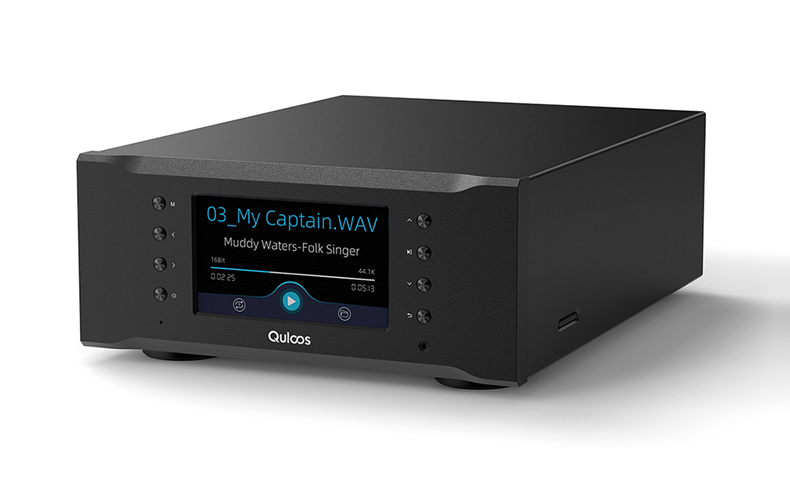 |
|
-------------- Good sound can be listened to every day --------------
Use the QA662 to achieve purer sound, more details, and a larger sound field
|
|
|
|
|
QA662 is a comprehensive upgrade product we launched on the basis of QA661. Since QA661 was launched in 2015 and discontinued in 2019, the research and development of QA662 have lasted for many years. During these long years of research and development, we have been constantly challenging the ceiling of sound quality and have gradually created the sound performance that we are proud of today. QA662 focuses on providing pure digital audio output, without analog output. Our original intention is to improve the output quality of digital audio in the user system through QA662, ensuring the ceiling of sound quality from the source. Therefore, QA662 cannot be directly connected to a headphone amplifier or an analog input power amplifier, but needs to work in conjunction with a DAC decoder or some other device that supports digital audio input. We firmly believe that it is precisely because QA662 focuses on the excellent performance of digital audio output that can push the quality of digital audio to a new level.
|
|
| One machine functions like five |
|
|
It integrates five functions, namely mcu pure sound player, USB bridge (similar to QU02+QP02), network bridge, Bluetooth reception, and coaxial audio signal optimization, which makes it meet more usage scenarios, provide better sound quality, and be more convenient.
|
|
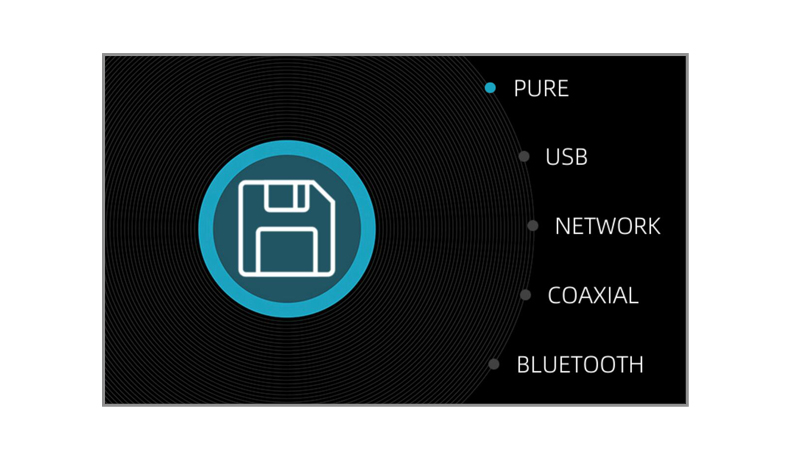
|
|
| Functional characteristics |
|
|
¡¾01¡¿Five input modes: Pure player, USB bridge, Network bridge, Bluetooth, Coaxial.
¡¾02¡¿5 output ports: I2S, RCA coaxial, BNC coaxial & word clock, Fiber optic, AES.
¡¾03¡¿Best clock process: SI5341 professional PLL, High precision and low jitter.
¡¾04¡¿Hi-End local crystal: AS338 crystal oscillator, 38fs ultra-low jitter.
¡¾05¡¿Clock scalability: Supports 10MHz reference clock input.
¡¾06¡¿Best PSU: 2 transformer, 3 linear power supply, isolated for the audio part.
¡¾07¡¿Best power circuit: 36 power chips achieve 26 sets of independent power ouput.
¡¾08¡¿high-performance power chips: Multiple expensive power chips such as LT3045.
¡¾09¡¿Uncompromising pure player: The minimal program architecture of the MCU.
¡¾10¡¿Improved USB Bridge: The Combo384 USB bridge with fully optimized.
¡¾11¡¿Best Network bridge: linear PSU, clock calibration, and regenerated audio signals.
¡¾12¡¿Best Bluetooth: deeply optimized sound quality, which rivals the wired connection.
¡¾13¡¿Practical coaxial input: signal reconstruction and clock calibration for best sound.
¡¾14¡¿Best power parts: Schurter power socket&Fuse, Alps switch, Talema transformer.
¡¾15¡¿Reasonable component usage at all costs: Using a lot of expensive hifi components.
|
|
| Clark's listening feeling |
|
|
In the exploration of the art of sound, QA662 is undoubtedly an ingenious craftsman. Its sound quality, although difficult to fully interpret with objective data, can show its unique charm by comparing with other equipment. Let's use the MBL1531A CD player purchased at a price of over 40,000 RMB as a reference. When comparing the music rerecorded from a CD by pure player through QA662 with that by playback of the original CD through MBL1531A, although the sound of the two were very similar at first hearing (because MBL1531A was also one of our reference machines we used for tuning sound), I could still feel something different when I listened through. QA662 sounded more penetrating, open and grand (with a larger sound field) than MBL1531A, but in terms of smoothness, dynamics, and liveliness, I could still feel that it was slightly inferior to MBL1531A. It is very difficult for the sound quality of an audio copied or rerecorded file by a digital player to achieve the effect of that of the original CD in a CD player of MBL1531A level, but QA662 has done its best to approach the level of such CD player.
Some old users are particularly concerned about the comparison between QA662 and QA661, the previous generation product. The sound of QA662 is more pure, solid, fine, and accurate than that of QA661. In terms of sound quality, QA662 has comprehensively improved. It shows a higher level of detail presentation, sound density, and extension of high and low frequency. The significant improvement is also reflected in the performance of the sound field. QA661 is like a gentle lady, while QA662 is like a grand hall with an impressive expansion of its sound field.
Some users also focus on the difference between the USB bridge of QA662 and that of QU02 + QP02. Because the design of QU02 originates from the USB bridge part of QA662, the sound of the two is actually very similar. It can be said that the USB bridge of QU02 + QP02 is at the same level as that of QA662 in terms of the performance of sound quality but with slight differences in style. For example, the USB bridge of QA662 will have a larger sound field, and be more pure, penetrating, and cohesive, while that of QU02 + QP02 will be more smooth and a little more charming.
|
|
| Si5341 radar-grade PLL clock synthesizer |
|
|
The special feature of QA662 is the use of Silicon LABS' Si5341 professional-grade clock synthesizer (PLL phase-locked loop) to generate the clock required for the overall unit. This outstanding PLL (Phase-Locked Loop) technology is usually only applied to equipment with high requirements such as radar and high-precision electronic instruments. We chose Si5341 to bring unprecedented clock precision and stability to QA662.
The addition of Si5341 means that QA662 can synthesize any desired clock frequency based on the reference clock, and truly realize the synchronous and precise control of the global clock of the overall unit. Its outstanding performance is reflected in clock jitter of only 90fs and the ability to generate any frequency in the range of 1Hz to 350MHz. This level of clock precision provides a solid foundation for accurate reproduction of sound quality.
Imagine that every rise and fall of the note is as precise and flawless as a live performance, every detail of the music is clear and distinguishable, and the dynamic range is wide, making you feel as if you were at a musician's live performance. This is exactly the unique charm that Si5341 brings to QA662, and it is also the goal that we unremittingly pursue.
Not only that, QA662 also has a built-in AS338 crystal oscillator designed specially for the Hi-END level, which, in conjunction with Si5341, ensures unparalleled precision of the clock. If you need to further improve sound quality in the future, QA662 also allows you to connect an external 10MHz clock with higher performance to meet your endless desire for sound quality.
|
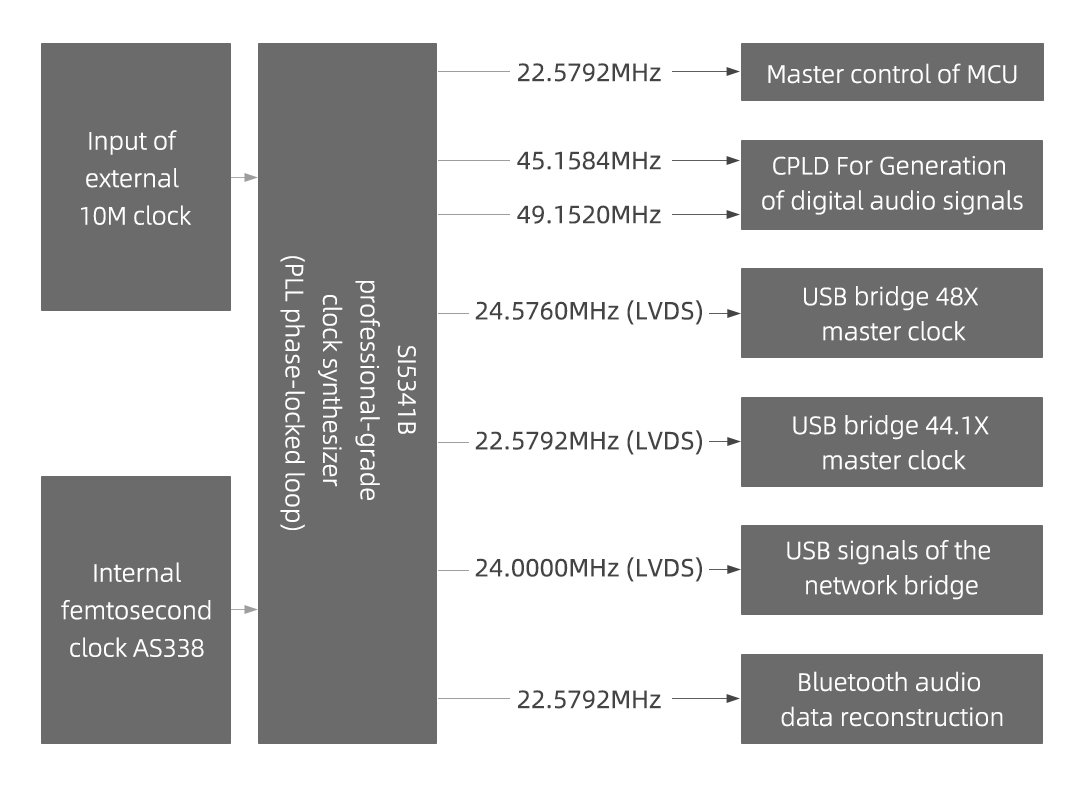 |
Lower clock jitter brings better sound quality, and the medium and low frequency quality to which human ears are sensitive has been significantly improved. With resilience of the sound, the instruments and vocals have a tangible imaging sense that seems to be within reach. At the same time, the high frequency is more fine, delicate, and accurate due to low jitter. |
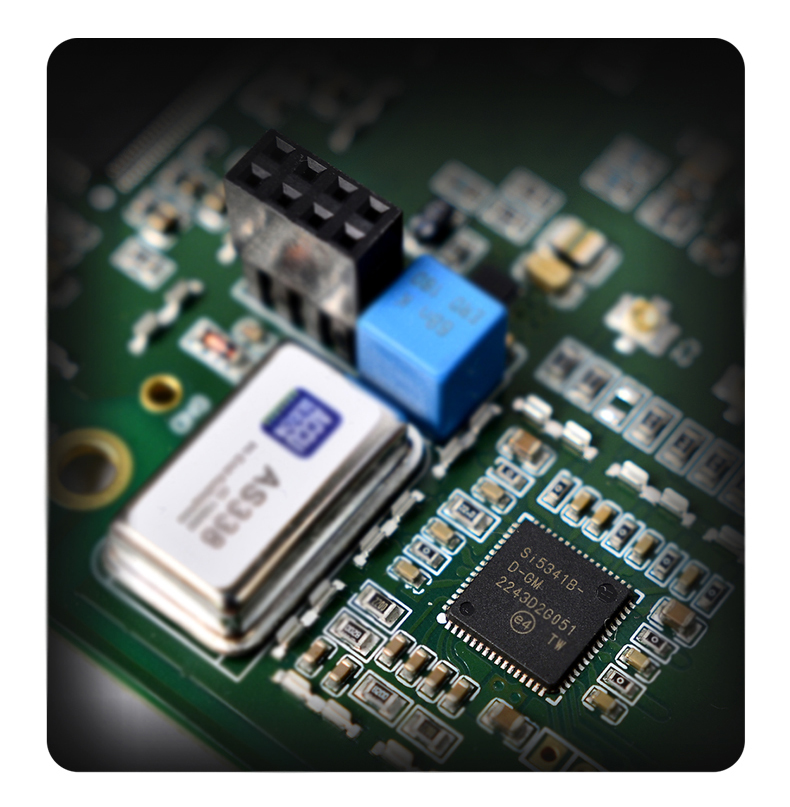 |
| Comparison of AS338 with other crystal oscillators |
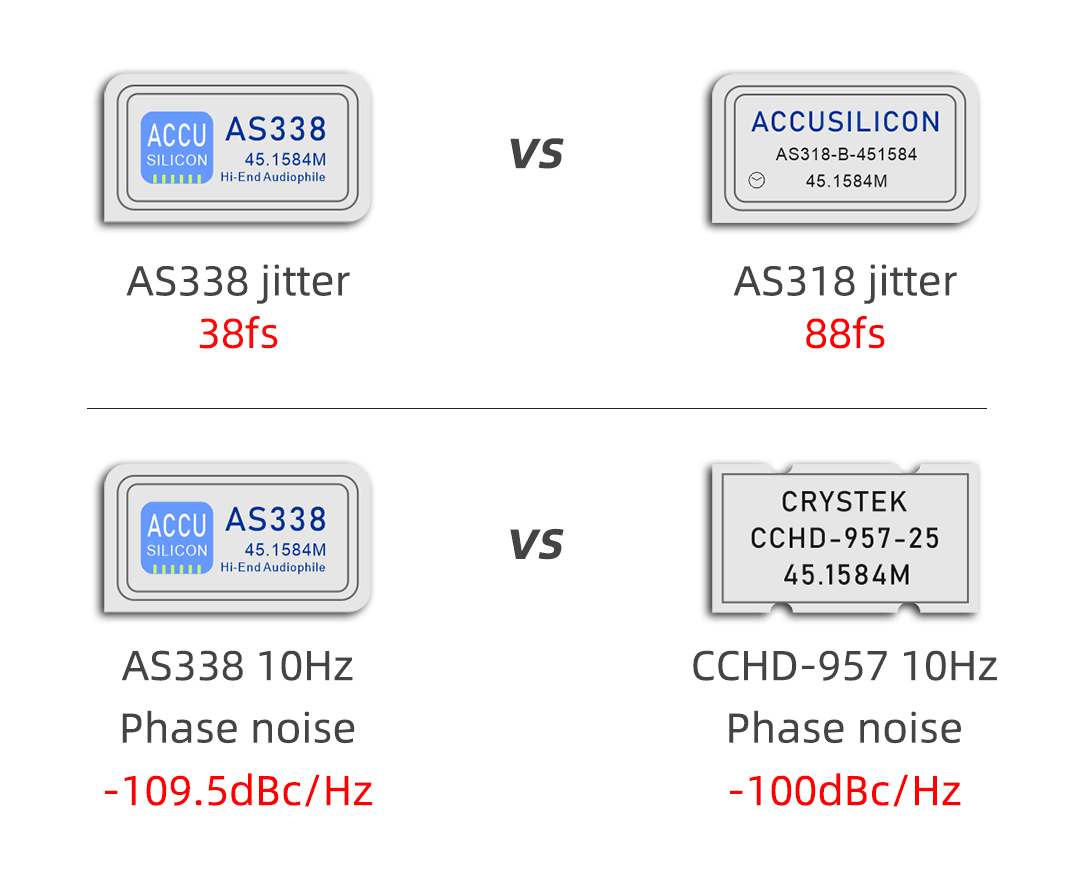 |
|
| Three ultra-silent linear power supplies |
|
|
We use two Talema sealed transformers to provide three ultra-silent linear power supplies for QA662. One of the transformers is designed to provide strong and quiet power support for the network bridge, while the other one has two channels of AC output, with two independent linear power supplies for the audio circuit and the control circuit, respectively. They are isolated from each other, greatly reducing mutual interference, thus effectively reducing noise and making the sound quality more pure and natural.
The MCU and display screen are equipped with a dedicated power supply, which is completely separated from sensitive audio components. Such physical separation and independent circuit design reduce interference to almost zero, ensuring the purity of the audio signal. When you listen to the music played by QA662, you can enjoy an unprecedented clarity and detail performance, allowing you to immerse yourself in a pure music world.
|
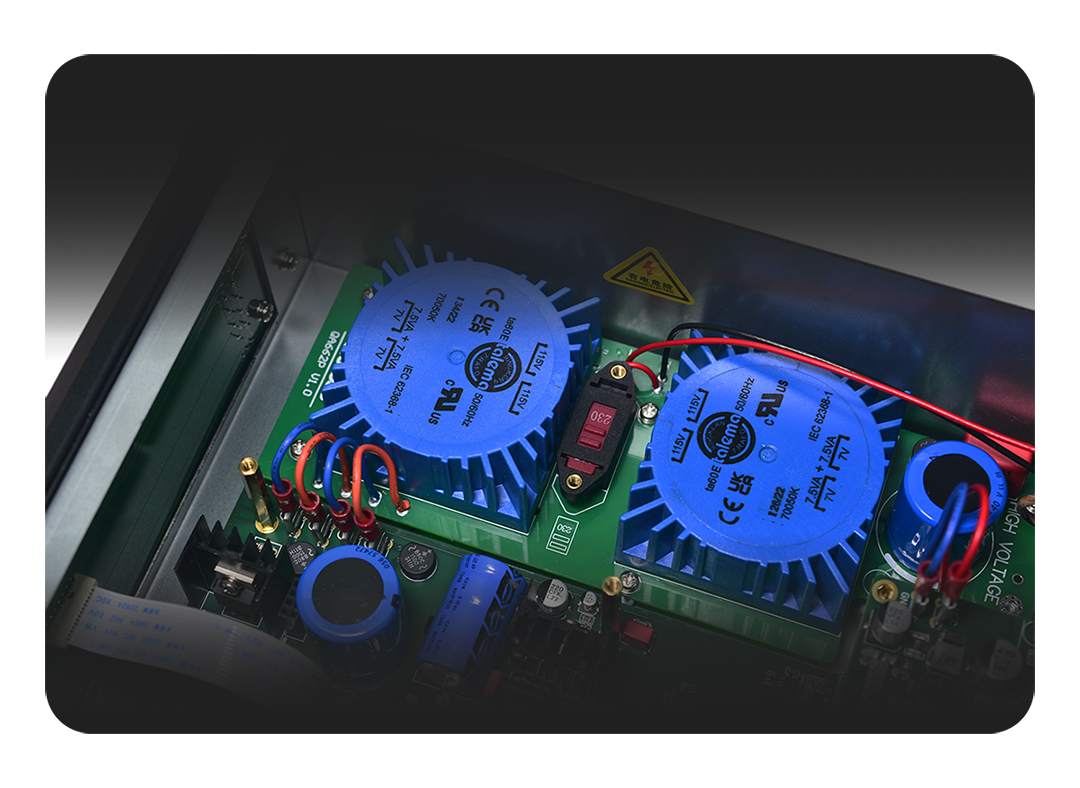 |
|
| When it comes to power supply, no cost is too much |
|
|
Electricity is the mother of sound, and power supply design is the key to ensuring that the audio player produces pure and high-quality sound.
In the product design of Quloos, we always prioritize the optimization of the power circuit in cost input. Because we have found that even the fine adjustment of each component in the power circuit will have a profound impact on sound performance. The logic behind this is clear - after all, all audio signals originate from the power supply, just as a child's appearance will always resemble his or her mother.
Power supply design is also the core of the cost gap between different equipment. For example, the price of a high-quality Linear power chip is often 10 to 20 times that of an ordinary power chip. For a device like QA662, which has dozens of such built-in high-quality power chips, the cost gap is naturally significant.
Although high-quality power chips are expensive, once they are put into use, their benefits are hard to give up. Their characteristic low noise, fast transient response, and rich and delicate sound details it brings to audio equipment make us willing to incorporate them into our circuit design at any cost.
|
| Comparison of noise and unit price of different power chips |
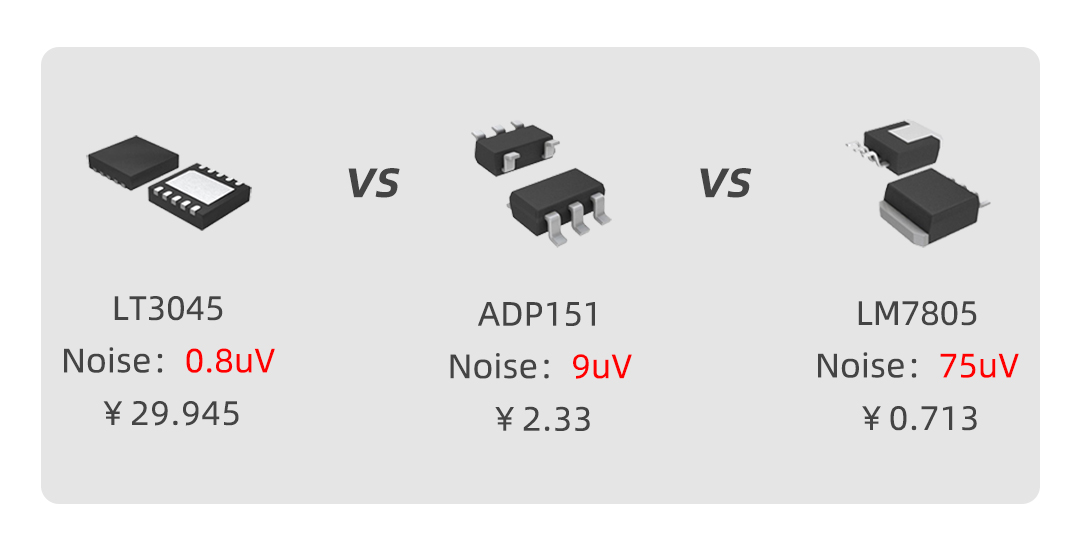 |
QA662 is equipped with the fourth generation power circuit of Quloos digital player. We use 36 high-performance power chips to build 26 sets of independent pure power output, ensuring that each audio processing part receives independent and undisturbed power supply, thus achieving the purity of audio playback.
|
|
| The sound quality is guaranteed, and the parameters are good too |
|
|
The power supply design regardless of the cost, together with professional-grade clock processing technology and outstanding digital signal processing, create the incredible low-jitter audio output of QA662. The jitter of its coaxial output drops to a striking 80ps, which is only 40% of the 200ps jitter of many single digital audio processing chips.
|
 |
The jitter test chart above is a test screenshot of the engineering machine on APX555. Because there will be a little deviation in the parameters of each machine, we conservatively choose the nominal value as 80ps. |
| Coaxial output THD+N and SINAD |
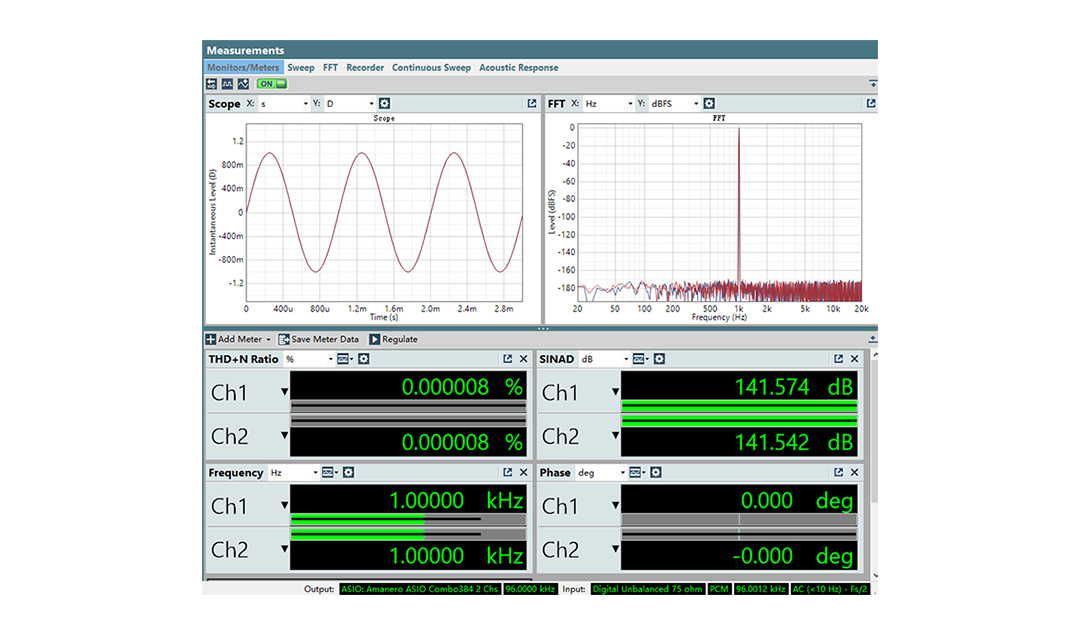 |
|
| Attention to details and reasonable component usage |
|
|
When it comes to improving sound quality, believe us, nothing can stop Quloos' efforts.
Quloos' careful, fast, broadband, pure, and reliable circuit design philosophy is continued. Short signal path and high-standard power supply design. Every detail, including the selection of the internal cable of the machine, the wiring of the PCB board, the design of the power supply circuit, the selection of each resistor, capacitor, and chip, as well as the optimization of shock absorption treatment and parts arrangement, all reflect the craftsman's unremitting pursuit of improving quality.
The power supply design regardless of the cost and the reasonable use of a large number of hifi parts are the solid foundation for QA662 to achieve the finest sound.
|
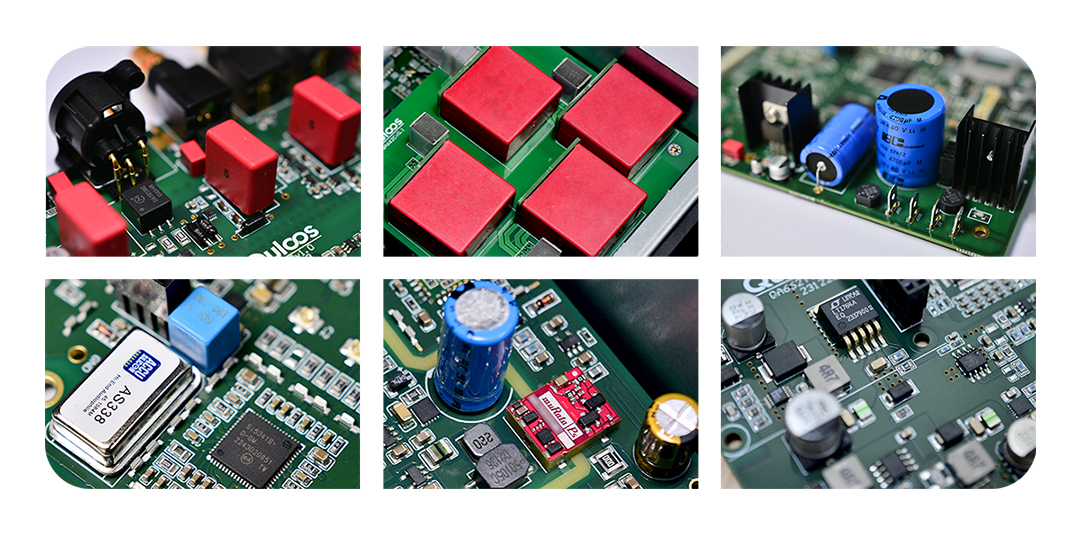 |
|
| True but surprising pure sound player |
|
|
It inherits the excellent lineage of QA661 and QA390, adheres to the concept of mcu single-threaded playback, ensures the precise and flawless digital output with a minimal program architecture, and pushes the purity of audio signals to a new level.
With the support of the fourth generation power circuit and professional-grade clock circuit, QA662 has achieved a striding improvement in sound quality on the basis of inheriting the outstanding genes of QA661. It not only ensures the purity, big scene, and precise reproduction of the sound, but also has a high "toxicity" (attracting people to keep listening), interpreting the true meaning of "true but surprising" with sound quality.
|
 |
Pure sound is not only a form of player, but also an audiophile attitude.
|
|
| Improved Combo384 USB bridge |
|
|
QA662 is equipped with the Combo384 USB bridge authorized by Amanero from Italy, and we have deeply optimized it. The complete isolation between the CPU section and sensitive audio components (including the clock section) further reduces interference. In addition, we have abandoned the conventional USB 5V power supply and use high-quality Murata isolated power supply. Local pure linear power supply is used at both ends of the isolation. With the precise global clock provided by AS338 and Si5341 and the professional-grade tuned digital audio output circuit, its sound quality performance has reached an unprecedented new level.
|
| Different complete ground wire full isolation technology |
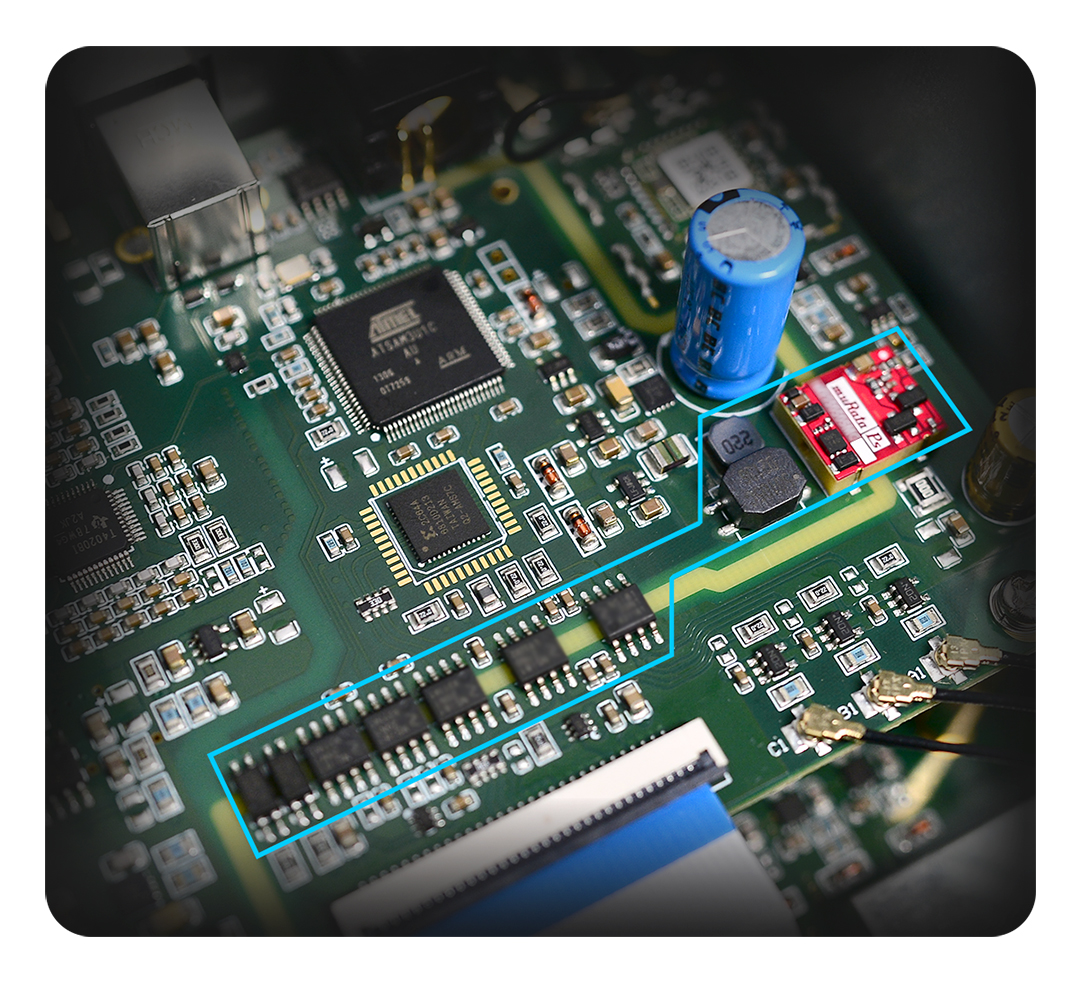 |
With the support of the isolation technology with local pure power supply before and after, we hear a quieter and calmer sound with a darker background and more details of off beat.
|
|
| Network bridge with amazing sound quality |
|
|
The network bridge of QA662 supports the push of mainstream streaming media such as UPNP(DLAN), Airplay, and Roon Bridge.
The network bridge section consists of two circuit boards, and the one floating above is a Linux system board resembling Raspberry Pi that anyone can buy. However, the circuit board below is the key to good sound.
It is easy to implement the network bridge function, yet the difficult part is to achieve good sound quality. The key is power supply and clock calibration, coupled with various isolation designs to eliminate digital interference caused by Linux operation.
All functions must be independently powered. To calibrate the clock well, not only should the clock be accurate, but also the power supply should work well. The master clock of the network stream and the audio USB, the audio I2S generation circuit, and the output circuit must all be independently powered. The power supply of each section shall have the characteristics of high bandwidth and low noise, as well as isolation design. This way, they won't affect each other, and this is the most difficult part in the design.
We have equipped it with an exclusive linear power supply, and multiple high-cost Linear power chips provide almost noise-free broadband power supply. Based on the high-precision and low-jitter technology of the global clock, we obtain pure and precise USB audio signals, which provides a solid foundation for audio output.
In addition, the improved Combo384 bridge shared by the network bridge and the USB bridge is fully isolated. The CPLD digital processing circuit independently powered by another linear power supply as well as the digital audio output circuit with excellently tuned sound make its sound quality more open, smooth, penetrating, and delicate, providing an auditory feast comparable to pure sound playback.
|
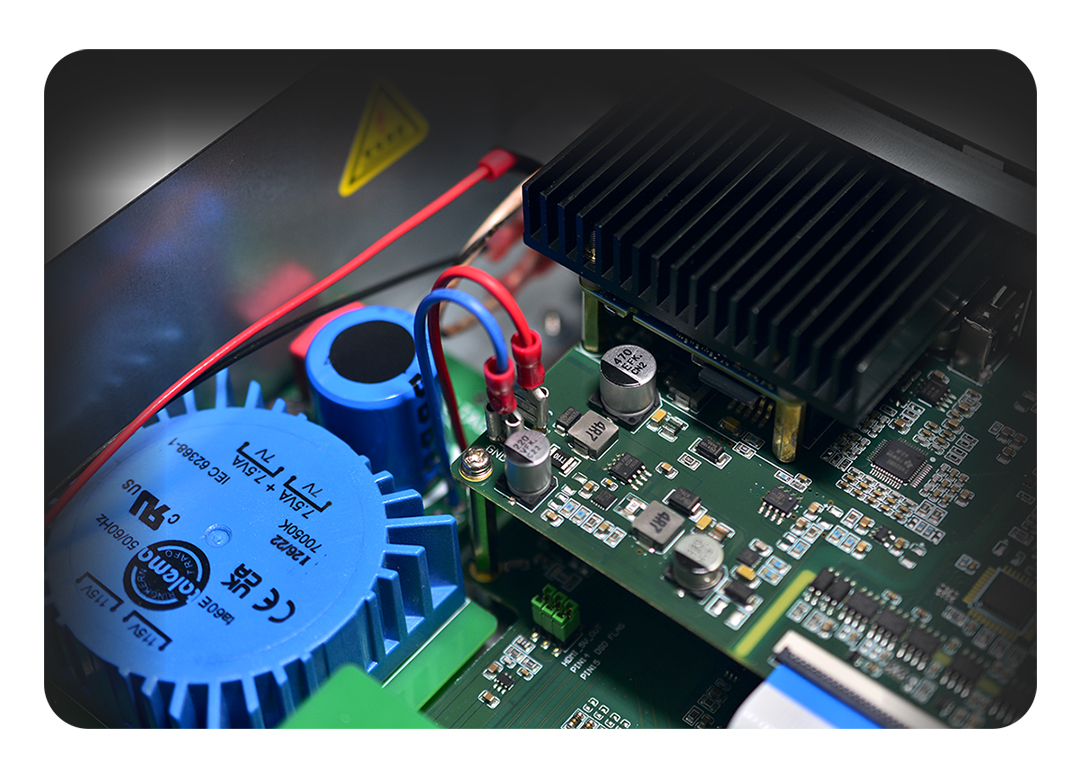 |
|
| Bluetooth input that rivals local sound quality |
|
|
Bluetooth has no usage threshold and is a very convenient streaming media input method. But to make Bluetooth valuable for use, sound quality is a key thing to be optimized. Make sure that it rivals the wired connection.
QA662 is equipped with the CSR8675 module that supports Bluetooth 5.0 technology and optimizes sound especially, which supports 24Bit / 96kHz high-definition Bluetooth input. We have comprehensively optimized Bluetooth input, and asynchronously regenerate frequency upconverted audio signals based on precise global clock, making the sound performance exceed the wired connection of most players. By choosing QA662, just the Bluetooth input makes you consider a super value.
|
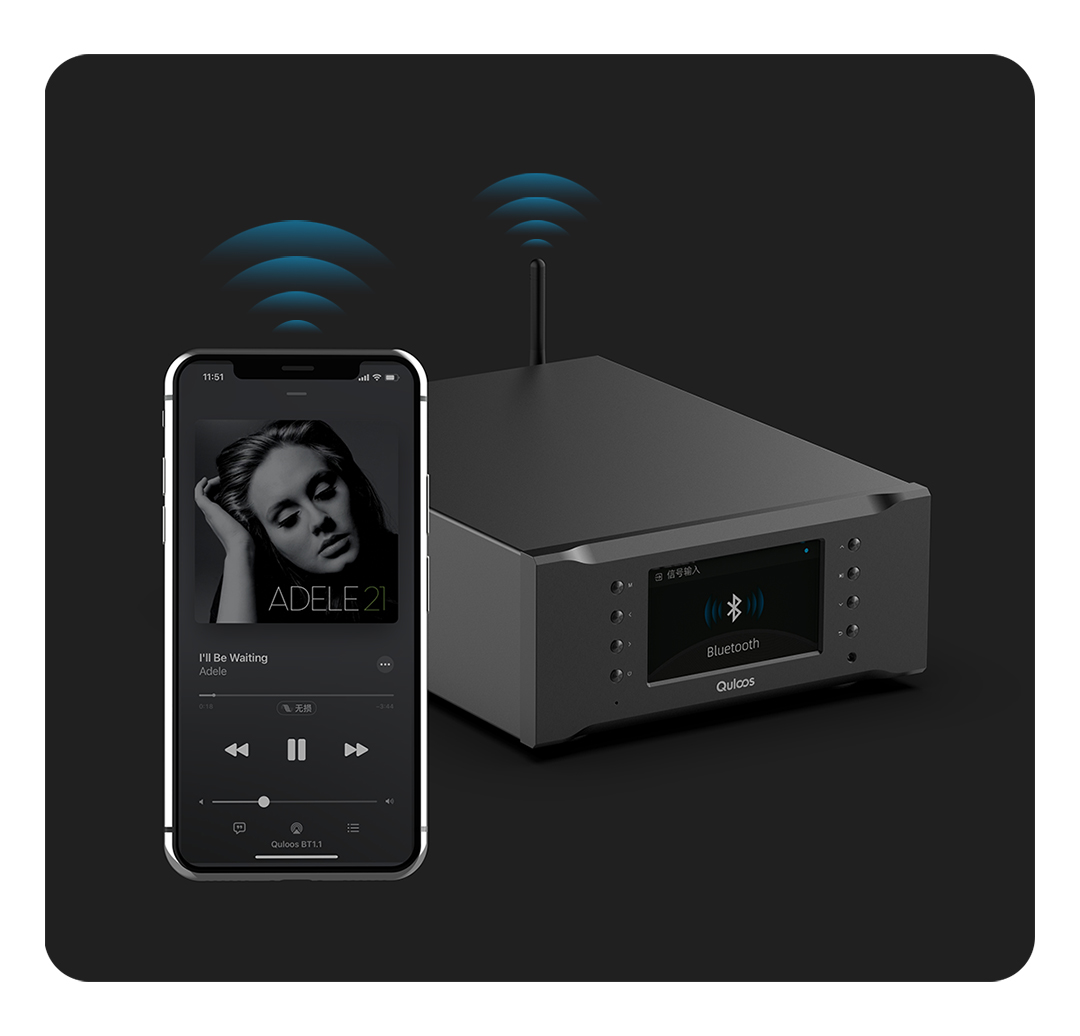 |
|
| Coaxial input for better sound quality |
|
|
QA662 also inherits a fun feature from QA661, which has a coaxial input port. The input coaxial signal can be reconstructed and optimized. Whether it's your TV set-top box, DVD, high-definition player, low-end CD player, Bluetooth or WIFI device..., as long as it has coaxial output, you can input data to QA662. After QA662 comprehensively reconstructs and optimizes the signals, the phase noise is greatly reduced, and the sound will become pleasanter.
After processing, the coaxial input will support coaxial, fiber optic, AES, and I2S interface outputs, which greatly improves playability.
Don't doubt it. Perhaps your much more expensive digital player can be input to QA662 to improve the sound quality.
|
 |
The coaxial output jitter of a digital player (before optimization)
|
 |
Coaxial output jitter after being input into QA662 and optimized (after optimization)
|
|
| I2S line sequence adjustable |
|
|
At present, there is still no unified standard for transmitting I2S signals via the HDMI interface, and there may be more or less differences in the definition of the interface among different products. Therefore, before using this interface, please confirm whether the interface definition of the backend device can match each other.
QA662 provides 4 different interface definitions by changing the "DSD channel" and "I2S phase" in the menu, which are basically compatible with most devices on the market that use the HDMI interface.
|
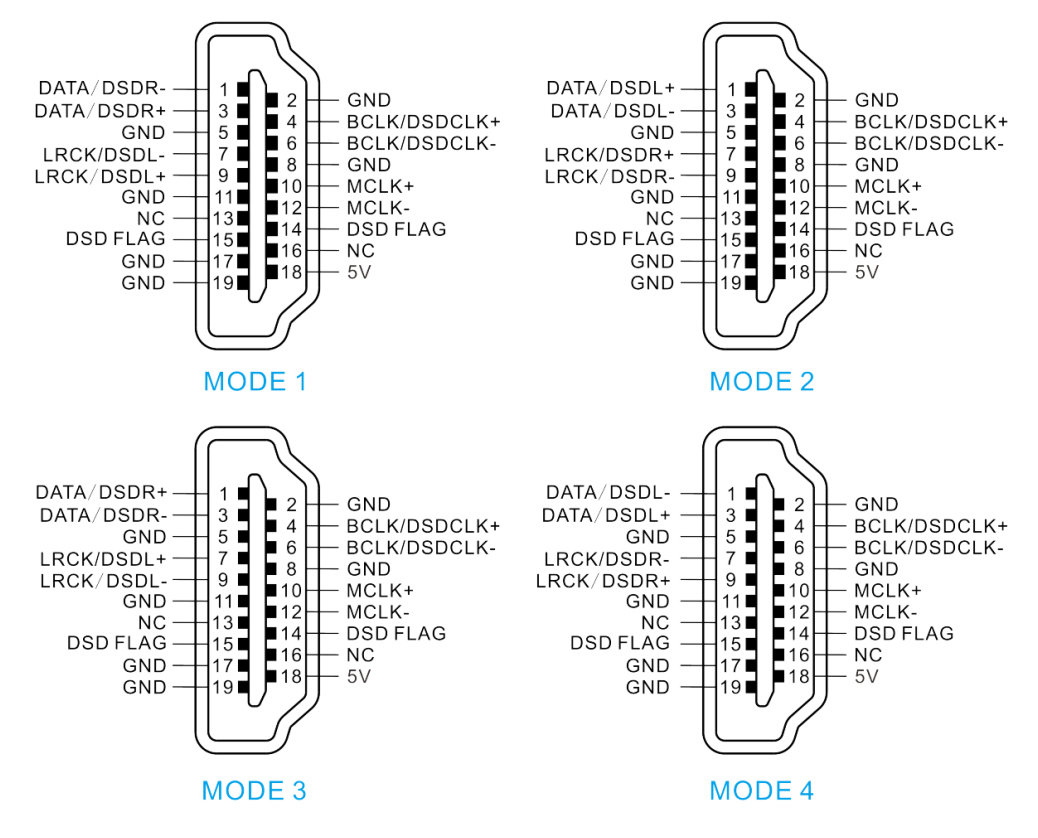 |
| MODE |
DSD Channel |
I2S MODE |
|
MODE 1 |
DSDL/LRCK |
Normal |
|
MODE 3 |
DSDL/LRCK |
Inverted |
|
| MODE |
DSD Channel |
I2S MODE |
|
MODE 2 |
DSDL/DATA |
Inverted |
|
MODE 4 |
DSDL/DATA |
Normal |
|
|
|
|
|
| ¡¡ |
| Supported music formats and sampling rates |
Pure Playback (SD Card) |
Format |
Maximum Sampling Bits/Sampling Rate |
Container, Encoding, Compression Level |
| WAV |
32Bit/192kHz | 24Bit/352.8kHz |
Fixed Point, Floating Point |
| AIFF |
32Bit/192kHz | 24Bit/352.8kHz |
|
| FLAC |
24Bit/352.8kHz |
Level 0~8 |
| ALAC |
24Bit/48kHz |
M4A Container |
| WavPack |
24Bit/48kHz |
Fast/Normal/High/High Plus |
| APE |
C1000:24Bit/192kHz
C2000:24Bit/192kHz
C3000:24Bit/192kHz
C4000:24Bit/96kHz |
Fast/Normal/High/High Plus |
| TTA |
24Bit/48kHz |
Fast/Normal/High/High Plus |
| DIFF |
DSD128 |
DST Encoding is Not Supported. |
| DSF |
DSD128 |
|
| SACD-ISO |
DSD64 |
|
| MP3 |
16Bit/48kHz | 96-320kbps |
CBR/VBR/ABR Encoding |
| AAC |
16Bit/44.1kHz |
M4A Container, AAC LC/SBR Encoding |
| DTS |
16Bit/44.1kHz |
WAV Container, DTS-5.1/DTS-ES Encoding |
| CUE |
ANSI/Unicode/Unicode Big Endian/UTF-8 Encoding |
| USB & Network streaming |
PCM 32Bit/384kHz, DSD512 |
| Bluetooth |
PCM 24Bit/96kHz
(Fixed output 24bit 88.2kHz) |
SBC/AAC/AptX etc. Encoding |
| Coaxial Input |
PCM 24Bit/192kHz, DSD64£¨DoP£© |
| COAX/OPT/AES Output |
PCM 24Bit/192kHz, DSD64£¨DoP£© |
| I2S Output |
PCM 32Bit/384kHz, DSD512 |
¡¡ |
| Parameter |
|
Input voltage |
AC 100-120V or 220-240V (factory preset,
refer to the voltage marked on the back of the
machine) |
| Fuse |
Slow fusing 1A, size 5 x 20 |
| Machine
power consumption |
<30W during operation and < 1W in standby
mode¡¡ |
| Outputs |
Coaxial: 75 ohms, 0.55Vpp
AES: 110 ohms, 3.3Vpp
I2S: 100 ohms, LVDS level
Word clock: 50 ohms, 3.3Vpp, TTL level
|
| Inputs |
Coaxial: 75 ohms
10MHz clock input: 50 ohms, 0.5 - 3.3VRMS |
| AES definition |
US standard (1 ground, 2 hot, 3 cold) |
| Systems supported by the USB input |
Windows (with ASIO drive), Mac, Android,
iOS, Linux (drive free) |
| Housing material |
Aviation aluminum |
| Host
dimensions |
216mm (width) x 302mm (depth) x 98mm
(height) (including exposed plugs, legs, and
buttons) |
| Host weight |
Without network bridge: 4.2kg,
With network bridge: 4.6kg |
|
Package dimensions |
450mm (length) x 290mm (width) x 170mm
(height) |
| Package weight |
Without network bridge: 5.3kg,
With network bridge: 5.7kg |
|
|
|
|
|
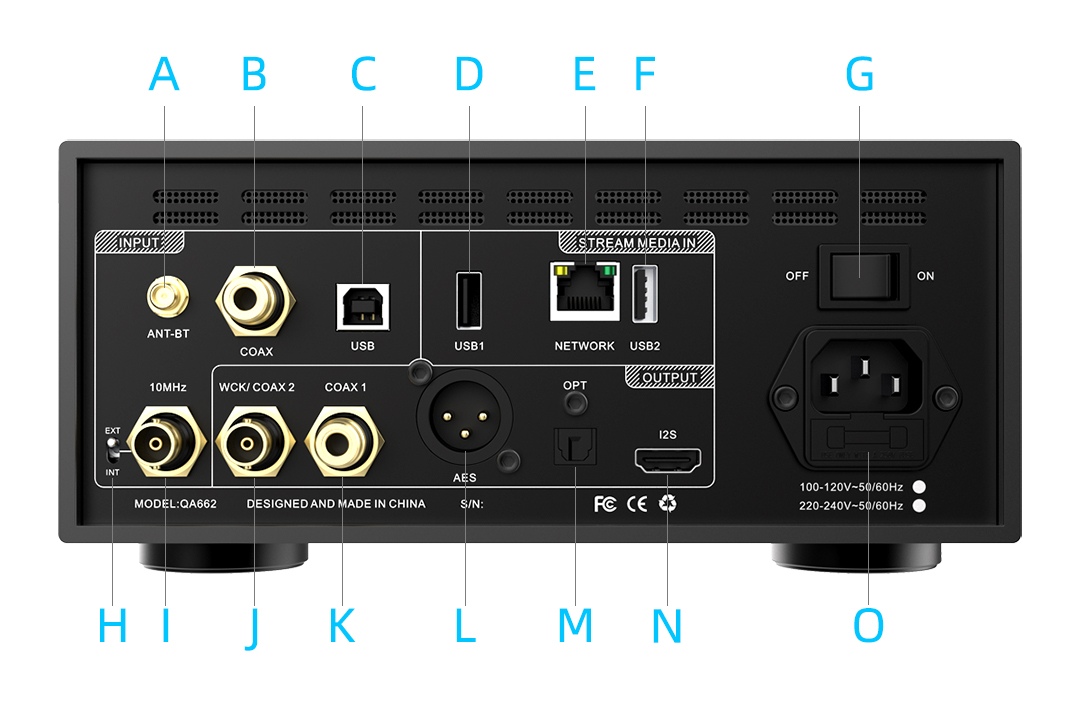 |
| A |
Bluetooth antenna interface |
| B |
RCA coaxial input interface |
| C |
USB bridge input |
| D |
Network bridge USB2.0 interface |
| E |
Network bridge gigabit network input
interface |
| F |
Network bridge USB3.0 interface |
| G |
Power switch of overall unit |
| H |
Internal clock / external clock select
switch |
| I |
10Mhz clock input interface |
| J |
Word clock/BNC coaxial output interface |
| K |
RCA coaxial output interface |
| L |
EBU/AES output interface |
| M |
Fiber optic output interface |
| N |
I2S (IIS) output interface |
| O |
110V / 220V AC input (including fuse) |
|
|
|
Reminders:
¡¾1¡¿If items, such as mobile phone, headphone, computer, desk, speaker, etc., which are not included in the QA662 packing list are shown in the picture, they are all display props and are not included in the product.
¡¾2¡¿The internal drawings, design framework drawings, test drawings, etc. of the product are for reference only. Any subsequent modifications will not be notified separately.
¡¾3¡¿The quantity related to power supply, as well as some pictures and content mentioned in the product introduction, are all based on the version with network bridge, while the version without network bridge may differ. No further explanation will be given.
¡¾4¡¿The product pictures are for reference only. Everything is subject to the actual product.
|
|
|
|
|
QA662 Host, Remote control, Power cord, SD card reader, 64GB SanDisk SD card (TF Card + Card holder), USB A to B cable, Bluetooth antenna, Manual, one for each.
|
Price:
QA662(Without network bridge): US $1099.00 (Not included shipping)
QA662(With network bridge): US $1299.00 (Not included shipping))
|
|
|
|
|